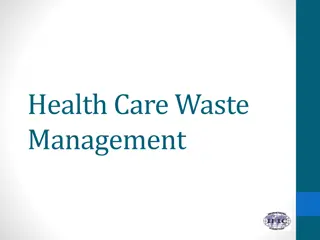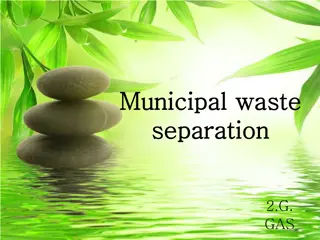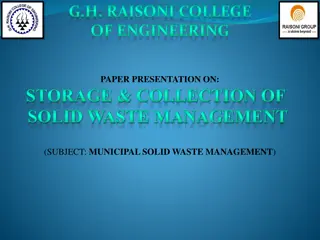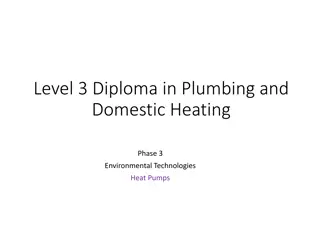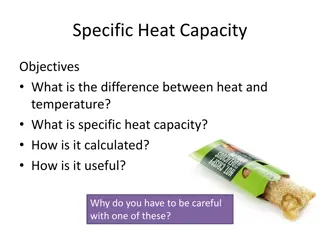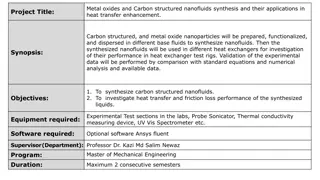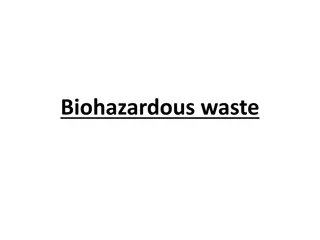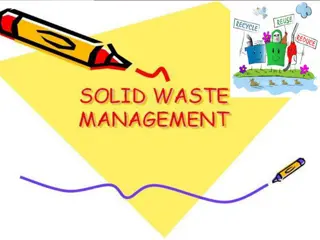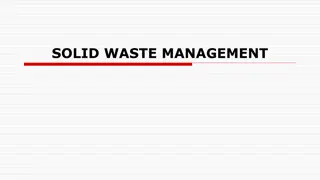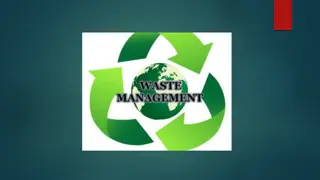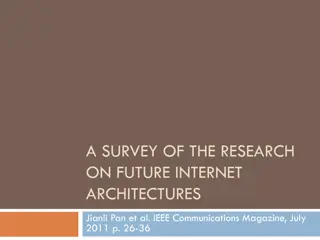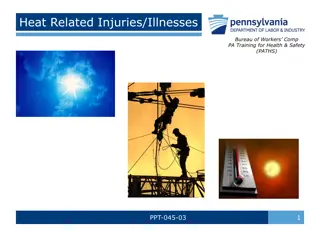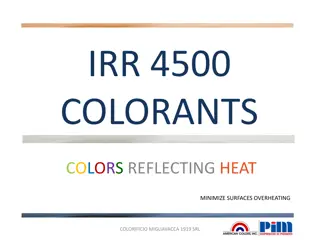Advanced ORC Architectures for Waste Heat Recovery at IIT Madras
Presentation of a novel Trans-critical Regenerative Series Two-Stage Organic Rankine Cycle (TR-STORC) by researchers Anandu Surendran and Satyanarayanan Seshadri at the 5th International Seminar on ORC Power Systems in Athens. The TR-STORC layout combines supercritical evaporation in the high-pressure stage with partial evaporation in the low-pressure stage, utilizing exhaust vapor superheat to maximize power output. Detailed discussions on existing ORC architectures, proposed solutions, optimization strategies, and future research directions were also presented.
Download Presentation

Please find below an Image/Link to download the presentation.
The content on the website is provided AS IS for your information and personal use only. It may not be sold, licensed, or shared on other websites without obtaining consent from the author. Download presentation by click this link. If you encounter any issues during the download, it is possible that the publisher has removed the file from their server.
E N D
Presentation Transcript
Indian Institute of Technology | Madras Potential of a Transcritical Regenerative Series Two Stage Organic Rankine Cycle for Dual Source Waste Heat Recovery Anandu Surendran Satyanarayanan Seshadri Ph.D Energy and Emissions Lab Department of Applied Mechanics Indian Institute of Technology| Madras 5th International Seminar on ORC Power Systems | Athens, Greece
Indian Institute of Technology | Madras Contents Existing ORC architectures Proposed architecture Heat source and modelling conditions Parameter studies Optimization and comparison Conclusion and future works 5th International Seminar on ORC Power Systems | Athens, Greece
Indian Institute of Technology | Madras Existing ORC solutions Pre-heated single stage ORC Dual-loop ORC 5th International Seminar on ORC Power Systems | Athens, Greece
Indian Institute of Technology | Madras Parallel Two stage ORC (PTORC) Series Two stage ORC (STORC) 5th International Seminar on ORC Power Systems | Athens, Greece
Indian Institute of Technology | Madras Why advanced ORC architectures for more than one heat source ? More often multiple heat sources exist concurrently Existing complex architectures are less economical All existing architectures are of lower thermal efficiency Inability to fully utilize all the heat sources when multiples heat sources are present What could be done? Supercritical evaporation Partial evaporation Stream splitting ORC System Reducing heat exchanger requirements Utilizing superheat after expansion 5th International Seminar on ORC Power Systems | Athens, Greece
Indian Institute of Technology | Madras What is being proposed? An advanced ORC layout: Trans-critical Regenerative Series Two Stage Organic Rankine Cycle (TR-STORC) Novel architecture that combines supercritical evaporation in high pressure (HP) stage and partial evaporation in low pressure (LP) stage Utilizes the superheat of exhaust vapour from HP turbine in the regenerator to fully evaporate the working fluid in LP stage and boost power output TR-STORC layout T-s diagram of TR-STORC 5th International Seminar on ORC Power Systems | Athens, Greece
Indian Institute of Technology | Madras Heat source: Stationary IC Engine 2.9 MW natural gas engine Used as stationary power generation units in steel plants and other process industries Heat Sources from a Gas Engine Engine jacket cooling water Engine lubrication oil cooling First stage air intake intercooler Engine exhaust gases Engine generator radiated heat Heat from second stage intercooler Exhaust gases Hot water First three are recovered as hot water on a 70/90 C flow return basis Primary heat source : Exhaust gases (Tp= 432 C, mp=16,528 kg/h) Secondary heat source : Hot water (Ts= 90 C, ms=50,400 kg/h) Working fluid : Cyclopentane 5th International Seminar on ORC Power Systems | Athens, Greece
Indian Institute of Technology | Madras Cycle parameters Parameter Value Tevap,HP (K) Tevap,LP (K) Tcond (K) e (%) p (%) PP (kPa) TP, outmin (K) Tsink, in (K) Tsink, out (K) 20 T pinch HP evaporator 10 T pinch LP evaporator 10 T pinch condenser Isentropic expander efficiency 70 Isentropic pump efficiency 80 Primary heat carrier pressure 101.325 Primary heat source cooling limit 373 Inlet temperature cooling water 298 Outlet temperature cooling water 303 All processes are at steady state Pressure drop and heat transfer from the pipelines is neglected Changes in kinetic and potential energy of the working fluid is negligible All heat exchangers are counter flow type Both LP and HP turbine stages have same isentropic efficiency MATLAB model integrated with REFPROP 5th International Seminar on ORC Power Systems | Athens, Greece
Indian Institute of Technology | Madras Modelling equations and procedure W = (W = + W /Q - ) LP (W - W ) net exp, W HP exp, pump, HP pump, LP th net total U U VFR VFR p = = Q (Q /Q + /V V = V = HP evap P, all Q )/Q s LP evap LP pre - heater S, all HP 6 5 /V LP 7 3" Discretized heat exchanger model with N=50 in HP evaporator for capturing the cooling curve and pinch point location N=30 for condenser and LP evaporator Mass flow rate in HP and LP loops are calculated iteratively Search technique to find the optimum vapor fraction in LP evaporator outlet 5th International Seminar on ORC Power Systems | Athens, Greece
Indian Institute of Technology | Madras Influence of HP evaporation pressure and vapor outlet temperature 5.0MPa 5.5MPa 6.0MPa 6.5MPa 7.0MPa 7.5MPa 0.64 416 0.62 414 0.60 412 Optimum vapor fraction q 0.58 410 Wnet (kW) 0.56 408 0.54 406 0.52 404 5.0MPa 5.5MPa 6.0MPa 6.5MPa 7.0MPa 7.5MPa 0.50 402 400 0.48 398 0.46 396 0.44 550 560 570 580 590 600 550 560 Vapor outlet temperature (K) 570 580 590 600 Vapor outlet temperature (K) At lower HP evaporator pressures, lower values of vapor outlet temperatures lead to maximum work output For higher HP stage pressures ,the optimum vapor fraction is higher for a given vapour outlet temperature 5th International Seminar on ORC Power Systems | Athens, Greece
Indian Institute of Technology | Madras Influence of HP evaporation pressure and vapor outlet temperature 17 90 30 Secondary heat source utilizaiton rate Us (%) 5.0MPa 5.5MPa 6.0MPa 6.5MPa 7.0MPa 7.5MPa 5.0MPa (Up) 7.5MPa (Up) 5.0MPa (Us) 7.5MPa (Us) Primary heat source utilizaiton rate Up (%) 88 28 Thermal efficiency (%) 16 86 26 84 24 15 82 22 14 80 20 550 560 570 580 590 600 550 560 Vapor outlet temperature (K) 570 580 590 600 Vapor outlet temperature (K) Up remains almost constant with vapour outlet temperature The peaks in Us correspond to maximum mass flow rates in the pre-heater section of LP evaporator The variation in thermal efficiency is a direct result of the variation in net power output and heat source utilization rates 5th International Seminar on ORC Power Systems | Athens, Greece
Indian Institute of Technology | Madras Influence of LP evaporation temperature (pressure) 410 Utilization rate of secondary heat source Us (%) 580K/ 5.0 MPa 580K/ 6.0 MPa 580K/5.0MPa 580K/6.0MPa 55 18 405 50 400 Net work output (kW) 45 16 Thermal efficiency (%) 40 395 35 390 14 30 385 25 580K/ 5.0 MPa 600K/ 5.0 MPa 580K/ 6.0 MPa 600K/ 6.0 MPa 12 380 20 375 15 10 370 10 320 325 330 335 340 345 350 320 325 330 335 340 345 350 LP evaporation temperature (K) LP evaporation temperature (K) At lower values of T3, higher utilization of secondary heat is seen At lower values of T3, the thermal efficiency of the LP stage decreases resulting in lower power outputs An intermediate value of T3 exists that maximizes the net power output of the TR- STORC. 5th International Seminar on ORC Power Systems | Athens, Greece
Indian Institute of Technology | Madras Cycle optimization : Parameters and Constraints Parameter Value T6 T3 560-600K 323K (Ts,in - Tevap,LP)K 1.1 Pc- 8MPa 313K-333K PHP evap Tcond Constraints Pcond VFR HP turbine 1.20 bar <= 50 VFR LP turbine <= 50 Degree of sub cooling 5K Tp,out min 373K GA parameters Population size 20 Maximum generations 15 Function tolerance 0.01kW The maximum operating temperature of the working fluid is set as the upper limit on the vapor outlet temperature Condenser pressure is kept above atmospheric pressure to prevent air leakage into the system Volumetric flow ratios (VFR) of both HP and LP turbines are constrained within 50 so that single stage turbines with can be used (Invernizziet al., 2007) The cooling limit on the primary heat source is set to 373K to prevent acid droplet formation Genetic Algorithm (GA) with net power output as the objective function Compared with an optimized STORC and pre-heated ORC for various cases 5th International Seminar on ORC Power Systems | Athens, Greece
Indian Institute of Technology | Madras Optimization results : At engine design point Parameters Pre-heated ORC STORC TR-STORC Wnet (kW) I (%) ex(%) Up (%) Us (%) mwf(kg/s) Tevap,LP (K) Tevap,HP (K) Pevap,HP (MPa) VFRLP VFRHP UA (kW/K) W/UA 280 14.4 14.2 81.5 5.20 3.50 - 460 2.18 - 21.6 117 2.46 297 12.2 15.0 81.6 18.4 4.85 344 460 2.18 1.6 13.5 147 2.02 344 15.3 17.4 81.6 13.3 4.84 347 582 6.83 1.7 45.2 149 2.31 TR-STORC delivers the highest power output which is 16% higher than STORC and 23% than pre-heated ORC TR-STORC also has the highest thermal efficiency, 6% higher than pre-heated ORC and 25% higher than STORC Us increased by 2.6 times than pre-heated ORC Comparable mass flow rates and UA requirements with STORC 5th International Seminar on ORC Power Systems | Athens, Greece
Indian Institute of Technology | Madras Optimization results : Influence of heat source temperatures and heat content 60 673K TR-STORC 673K STORC 773K TR-STORC 773K STORC 18 TR-STORC STORC 16 50 14 Tp= 673K , Ts= 363K 40 12 (%) (%) 10 30 8 20 6 10 4 2 0 0.2 0.4 0.6 0.8 Heat ratio 1.0 1.2 1.4 1.6 360 365 Secondary heat source temperature Ts,in (K) (W = STORC power, 370 375 380 385 390 395 - W )/W 100 Baseline : Pre-heated single stage ORC net, STORC net, preORC net, preORC 14%-20% more power output than STORC As the secondary heat source temperature increases, the relative increase in power output of TR-STORC and STORC exceeds that of pre-heated For the heat ratios investigated, TR-STORC delivers 4.8-5.5% increased power output than STORC. 5th International Seminar on ORC Power Systems | Athens, Greece
Indian Institute of Technology | Madras Summary and Conclusions A two stage cycle architecture that improves on the existing STORC architecture by combining supercritical heating in the HP stage and partial evaporation and regeneration in the LP stage is proposed 2.9MW Stationary gas engine is selected as the heat source Results are compared with optimized pre-heated ORC and STORC The main conclusions are: For a 2.9MW natural gas engine, TR-STORC delivers 16% and 23% higher power output than STORC and pre-heated ORC respectively Us increased by 2.6 times than pre-heated ORC TR-STORC has 6% and 25& higher thermal efficiency than pre-heated ORC and STORC TR-STORC presents excellent exergetic performance for dual source heat recovery over STORC and pre-heated ORC 5th International Seminar on ORC Power Systems | Athens, Greece
Indian Institute of Technology | Madras Future works and leads Experimental validation of heat exchanger loop using throttle valves (in progress at IIT M) Experimental validation using expanders Study of supercritical nature of refrigerants, siloxanes and other alkanes Other possibilities WHR for petroleum refineries with multiple heat streams Combined solar+ geothermal applications Single heat source applications such as geothermal by temperature splitting Compete against supercritical CO2 systems at higher source temperatures 5th International Seminar on ORC Power Systems | Athens, Greece
Indian Institute of Technology | Madras Thank you.. Energy and Emissions Lab Indian Institute of Technology (IIT), Madras 5th International Seminar on ORC Power Systems | Athens, Greece
Indian Institute of Technology | Madras Contact details Anandu Surendran Research Scholar (Ph.D) FMB #121 Energy and Emissions Lab Fluid Mechanics Division Department of Applied Mechanics , IIT M Email: anandusurendran@smail.iitm.ac.in Ph no: 9446525291, 7550160214 Dr. Satyanarayanan Seshadri Assistant Professor FMB #201 Fluid Mechanics Division Department of Applied Mechanics , IIT M Email: satya@iitm.ac.in Ph no: 044-2257-4078, 9845068998 Energy and Emissions Lab | Department of Applied Mechanics
Indian Institute of Technology | Madras Appendix At design point Pressure ratio across HP turbine : 68 bar to 2.2 bar approx : 31 Pressure ratio across LP turbine : 2.2 bar to 1.2 bar approx : 1.8 Pressure limit: 80 bar 5th International Seminar on ORC Power Systems | Athens, Greece
Indian Institute of Technology | Madras References L. Shi, G. Shu, H. Tian, and S. Deng, A review of modified Organic Rankine cycles (ORCs) for internal combustion engine waste heat recovery (ICE-WHR), Renew. Sustain. Energy Rev., vol. 92, pp. 95 110, Sep. 2018. I. Vaja and A. Gambarotta, Internal Combustion Engine ( ICE ) bottoming with Organic Rankine Cycles ( ORCs ), Energy, vol. 35, no. 2, pp. 1084 1093, 2010. G. Shu, L. Liu, H. Tian, H. Wei, and G. Yu, Parametric and working fluid analysis of a dual-loop organic Rankine cycle (DORC) used in engine waste heat recovery, Appl. Energy, vol. 113, 2014. G. Manente, A. Lazzaretto, and E. Bonamico, Design guidelines for the choice between single and dual pressure layouts in organic Rankine cycle (ORC) systems, Energy, vol. 123, pp. 413 431, 2017. J. Li, Z. Ge, Y. Duan, and Z. Yang, Design and performance analyses for a novel organic Rankine cycle with supercritical-subcritical heat absorption process coupling, Appl. Energy, vol. 235, pp. 1400 1414, Feb. 2019. S. Rech, S. Zandarin, A. Lazzaretto, and C. A. Frangopoulos, Design and off-design models of single and two-stage ORC systems on board a LNG carrier for the search of the optimal performance and control strategy, Appl. Energy, vol. 204, pp. 221 241, Oct. 2017. T. Chen, W. Zhuge, Y. Zhang, and L. Zhang, A novel cascade organic Rankine cycle (ORC) system for waste heat recovery of truck diesel engines, Energy Convers. Manag., vol. 138, pp. 210 223, 2017. T. Li, Z. Zhang, J. Lu, J. Yang, and Y. Hu, Two-stage evaporation strategy to improve system performance for organic Rankine cycle, Appl. Energy, vol. 150, pp. 323 334, 2015. S. Lecompte, H. Huisseune, M. Van Den Broek, and M. De Paepe, Methodical thermodynamic analysis and regression models of organic Rankine cycle architectures for waste heat recovery, Energy, vol. 87, pp. 60 76, 2015. U. Larsen, L. Pierobon, F. Haglind, and C. Gabrielii, Design and optimisation of organic Rankine cycles for waste heat recovery in marine applications using the principles of natural selection, Energy, vol. 55, pp. 803 812, 2013. C. Invernizzi, P. Iora, and P. Silva, Bottoming micro-Rankine cycles for micro-gas turbines, vol. 27, pp. 100 110, 2007. 5th International Seminar on ORC Power Systems | Athens, Greece








